The Assessment ASET Nursing - Communication, Assessment Process, and Strengths-based Nursing
VerifiedAdded on 2023/06/07
|11
|2604
|385
AI Summary
This article discusses the challenges faced by ASET nurses in communication with aged patients, the assessment process of old people, and the principles of strengths-based nursing. It also highlights the areas of assessment inadequately assessed in the video.
Contribute Materials
Your contribution can guide someone’s learning journey. Share your
documents today.
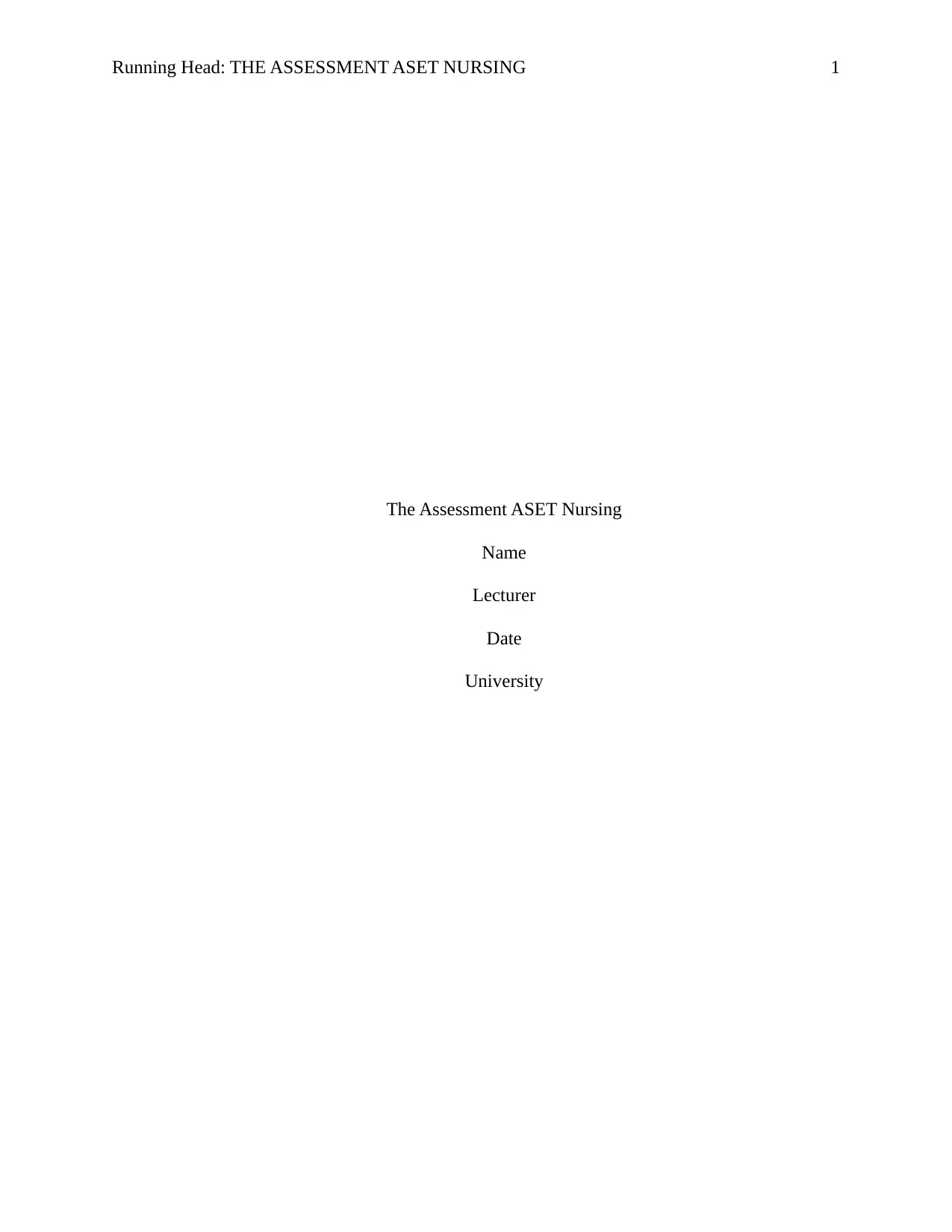
Running Head: THE ASSESSMENT ASET NURSING 1
The Assessment ASET Nursing
Name
Lecturer
Date
University
The Assessment ASET Nursing
Name
Lecturer
Date
University
Secure Best Marks with AI Grader
Need help grading? Try our AI Grader for instant feedback on your assignments.

THE ASSESSMENT ASET NURSING 2
The Assessment ASET Nursing
The Aged Care Services in Emergency Teams (ASET) operate within the healthcare
departments offer quality and professional health care to aged people. Their aim includes
extending improved healthcare outcomes for old people. Healthcare departments that deal with
aged people face difficulties. Staff, ASET nurses, and other healthcare providers involved in
taking care of the aged have communication barriers caused by various reasons (Christenbery,
2018). Effective nursing communication is important in the accurate assessment and diagnosis of
clients as well as the planning of nursing interventions (Melynk and Fineout-Overholt, 2011).
That has since changes because nurses are now viewed as collaborators in patient care together
with doctors and other members of the healthcare team (Ellis, 2016). The nursing profession is
now highly specialized to include various cadres and sub-specialties for nurses.
Among factors contributing to communication, barriers include physical and cognitive
impairment, cultural differences, poor hearing, limited health literacy, poor vision, and
generational beliefs (Ruoff and Hoffman, 2016). However, healthcare service providers and other
staff members have strategies for improving communication among aged patients. ASET nurse is
responsible for delivering quality services to older people. Their role includes offering
appropriate and well-coordinated assessments and care planning to the aged (Ni, 2014). They
also conduct consultation services for including offering health education as well as evaluation of
patient conditions. The operations involve monitoring patient progress and observing her status
from time to time while maintaining social relations by communicating (Ni, 2014).
Challenges Facing Max in Communication
Max has difficulties hearing. He is slow in responding to some questions. Max decides to
keep quiet in some instances especially when he fails to figure out what Robyn asked. Hearing
The Assessment ASET Nursing
The Aged Care Services in Emergency Teams (ASET) operate within the healthcare
departments offer quality and professional health care to aged people. Their aim includes
extending improved healthcare outcomes for old people. Healthcare departments that deal with
aged people face difficulties. Staff, ASET nurses, and other healthcare providers involved in
taking care of the aged have communication barriers caused by various reasons (Christenbery,
2018). Effective nursing communication is important in the accurate assessment and diagnosis of
clients as well as the planning of nursing interventions (Melynk and Fineout-Overholt, 2011).
That has since changes because nurses are now viewed as collaborators in patient care together
with doctors and other members of the healthcare team (Ellis, 2016). The nursing profession is
now highly specialized to include various cadres and sub-specialties for nurses.
Among factors contributing to communication, barriers include physical and cognitive
impairment, cultural differences, poor hearing, limited health literacy, poor vision, and
generational beliefs (Ruoff and Hoffman, 2016). However, healthcare service providers and other
staff members have strategies for improving communication among aged patients. ASET nurse is
responsible for delivering quality services to older people. Their role includes offering
appropriate and well-coordinated assessments and care planning to the aged (Ni, 2014). They
also conduct consultation services for including offering health education as well as evaluation of
patient conditions. The operations involve monitoring patient progress and observing her status
from time to time while maintaining social relations by communicating (Ni, 2014).
Challenges Facing Max in Communication
Max has difficulties hearing. He is slow in responding to some questions. Max decides to
keep quiet in some instances especially when he fails to figure out what Robyn asked. Hearing
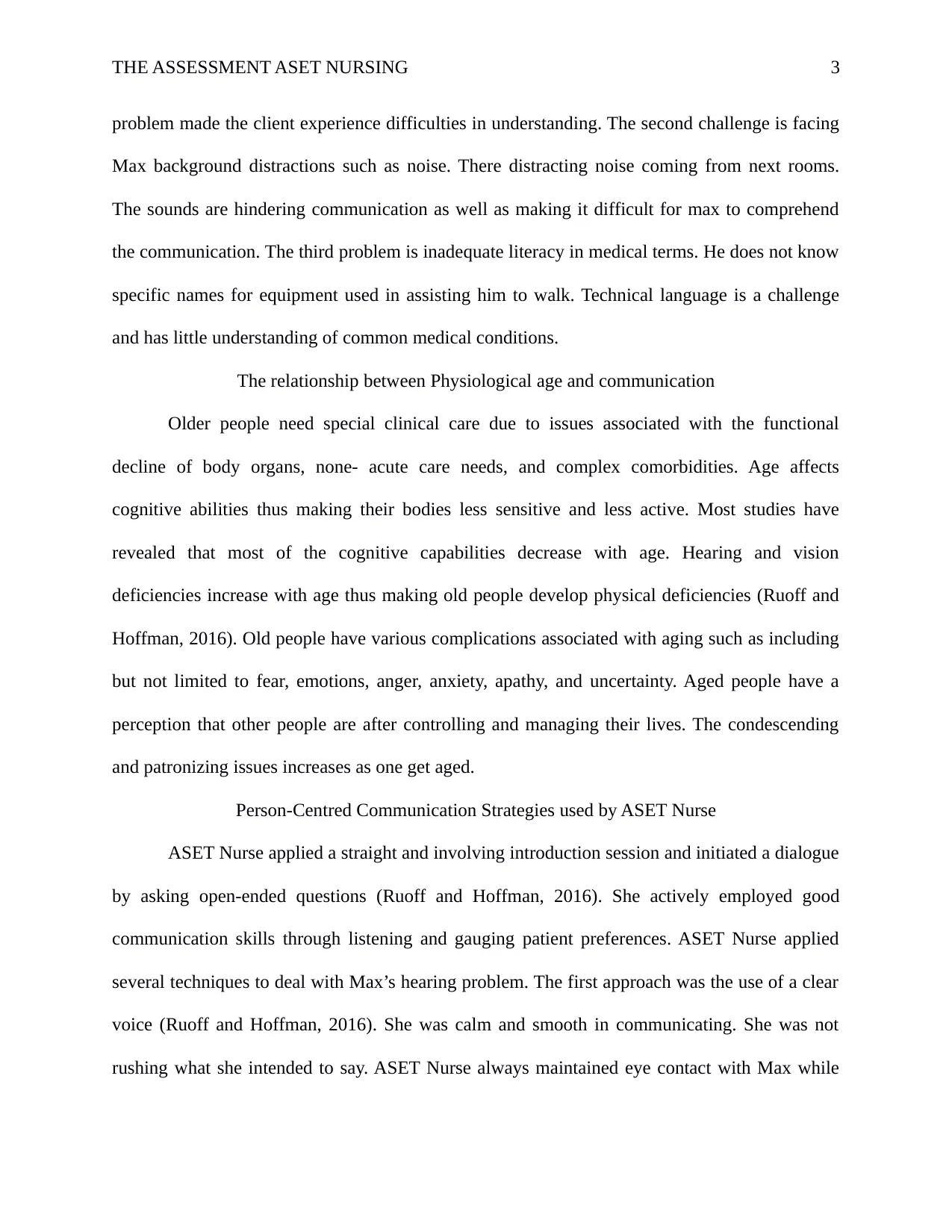
THE ASSESSMENT ASET NURSING 3
problem made the client experience difficulties in understanding. The second challenge is facing
Max background distractions such as noise. There distracting noise coming from next rooms.
The sounds are hindering communication as well as making it difficult for max to comprehend
the communication. The third problem is inadequate literacy in medical terms. He does not know
specific names for equipment used in assisting him to walk. Technical language is a challenge
and has little understanding of common medical conditions.
The relationship between Physiological age and communication
Older people need special clinical care due to issues associated with the functional
decline of body organs, none- acute care needs, and complex comorbidities. Age affects
cognitive abilities thus making their bodies less sensitive and less active. Most studies have
revealed that most of the cognitive capabilities decrease with age. Hearing and vision
deficiencies increase with age thus making old people develop physical deficiencies (Ruoff and
Hoffman, 2016). Old people have various complications associated with aging such as including
but not limited to fear, emotions, anger, anxiety, apathy, and uncertainty. Aged people have a
perception that other people are after controlling and managing their lives. The condescending
and patronizing issues increases as one get aged.
Person-Centred Communication Strategies used by ASET Nurse
ASET Nurse applied a straight and involving introduction session and initiated a dialogue
by asking open-ended questions (Ruoff and Hoffman, 2016). She actively employed good
communication skills through listening and gauging patient preferences. ASET Nurse applied
several techniques to deal with Max’s hearing problem. The first approach was the use of a clear
voice (Ruoff and Hoffman, 2016). She was calm and smooth in communicating. She was not
rushing what she intended to say. ASET Nurse always maintained eye contact with Max while
problem made the client experience difficulties in understanding. The second challenge is facing
Max background distractions such as noise. There distracting noise coming from next rooms.
The sounds are hindering communication as well as making it difficult for max to comprehend
the communication. The third problem is inadequate literacy in medical terms. He does not know
specific names for equipment used in assisting him to walk. Technical language is a challenge
and has little understanding of common medical conditions.
The relationship between Physiological age and communication
Older people need special clinical care due to issues associated with the functional
decline of body organs, none- acute care needs, and complex comorbidities. Age affects
cognitive abilities thus making their bodies less sensitive and less active. Most studies have
revealed that most of the cognitive capabilities decrease with age. Hearing and vision
deficiencies increase with age thus making old people develop physical deficiencies (Ruoff and
Hoffman, 2016). Old people have various complications associated with aging such as including
but not limited to fear, emotions, anger, anxiety, apathy, and uncertainty. Aged people have a
perception that other people are after controlling and managing their lives. The condescending
and patronizing issues increases as one get aged.
Person-Centred Communication Strategies used by ASET Nurse
ASET Nurse applied a straight and involving introduction session and initiated a dialogue
by asking open-ended questions (Ruoff and Hoffman, 2016). She actively employed good
communication skills through listening and gauging patient preferences. ASET Nurse applied
several techniques to deal with Max’s hearing problem. The first approach was the use of a clear
voice (Ruoff and Hoffman, 2016). She was calm and smooth in communicating. She was not
rushing what she intended to say. ASET Nurse always maintained eye contact with Max while
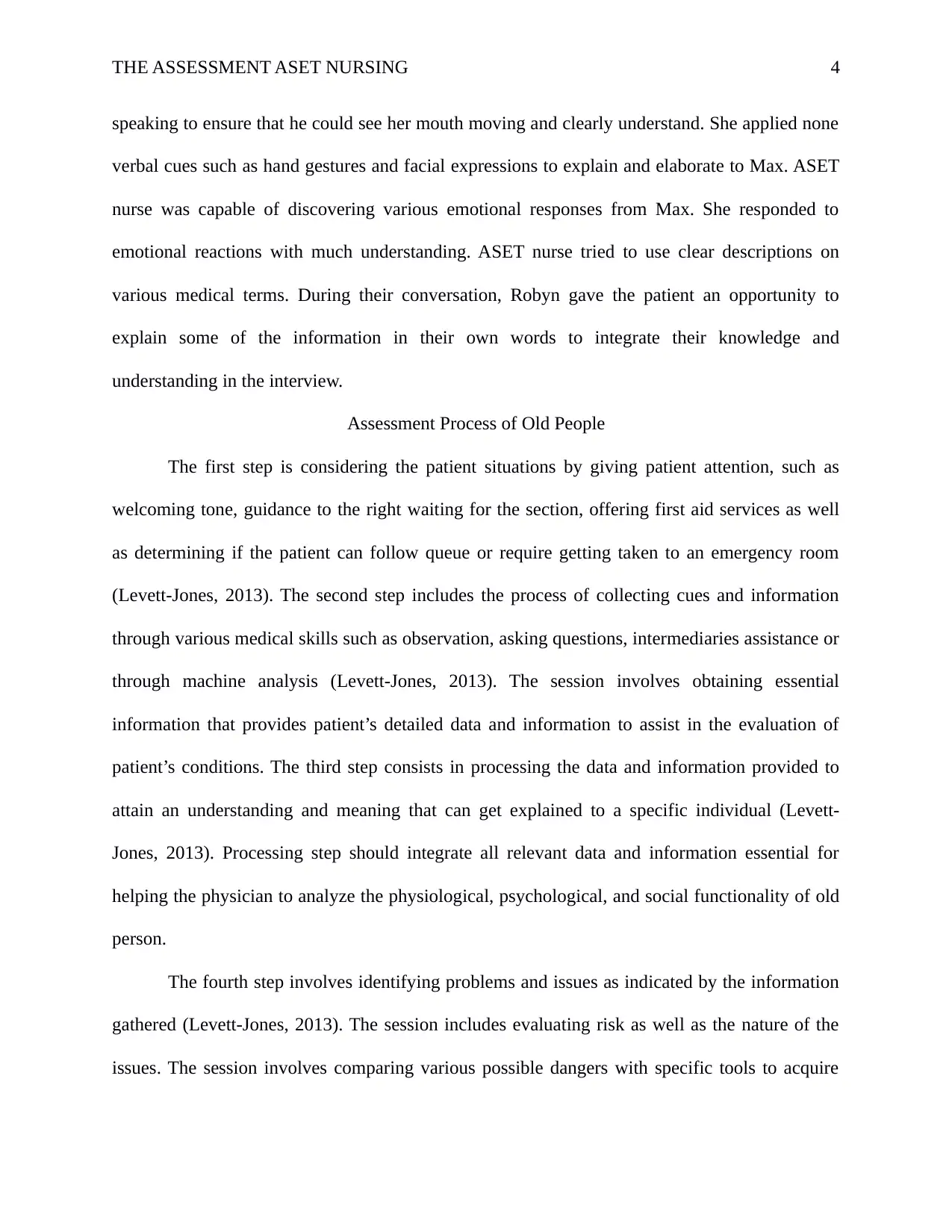
THE ASSESSMENT ASET NURSING 4
speaking to ensure that he could see her mouth moving and clearly understand. She applied none
verbal cues such as hand gestures and facial expressions to explain and elaborate to Max. ASET
nurse was capable of discovering various emotional responses from Max. She responded to
emotional reactions with much understanding. ASET nurse tried to use clear descriptions on
various medical terms. During their conversation, Robyn gave the patient an opportunity to
explain some of the information in their own words to integrate their knowledge and
understanding in the interview.
Assessment Process of Old People
The first step is considering the patient situations by giving patient attention, such as
welcoming tone, guidance to the right waiting for the section, offering first aid services as well
as determining if the patient can follow queue or require getting taken to an emergency room
(Levett-Jones, 2013). The second step includes the process of collecting cues and information
through various medical skills such as observation, asking questions, intermediaries assistance or
through machine analysis (Levett-Jones, 2013). The session involves obtaining essential
information that provides patient’s detailed data and information to assist in the evaluation of
patient’s conditions. The third step consists in processing the data and information provided to
attain an understanding and meaning that can get explained to a specific individual (Levett-
Jones, 2013). Processing step should integrate all relevant data and information essential for
helping the physician to analyze the physiological, psychological, and social functionality of old
person.
The fourth step involves identifying problems and issues as indicated by the information
gathered (Levett-Jones, 2013). The session includes evaluating risk as well as the nature of the
issues. The session involves comparing various possible dangers with specific tools to acquire
speaking to ensure that he could see her mouth moving and clearly understand. She applied none
verbal cues such as hand gestures and facial expressions to explain and elaborate to Max. ASET
nurse was capable of discovering various emotional responses from Max. She responded to
emotional reactions with much understanding. ASET nurse tried to use clear descriptions on
various medical terms. During their conversation, Robyn gave the patient an opportunity to
explain some of the information in their own words to integrate their knowledge and
understanding in the interview.
Assessment Process of Old People
The first step is considering the patient situations by giving patient attention, such as
welcoming tone, guidance to the right waiting for the section, offering first aid services as well
as determining if the patient can follow queue or require getting taken to an emergency room
(Levett-Jones, 2013). The second step includes the process of collecting cues and information
through various medical skills such as observation, asking questions, intermediaries assistance or
through machine analysis (Levett-Jones, 2013). The session involves obtaining essential
information that provides patient’s detailed data and information to assist in the evaluation of
patient’s conditions. The third step consists in processing the data and information provided to
attain an understanding and meaning that can get explained to a specific individual (Levett-
Jones, 2013). Processing step should integrate all relevant data and information essential for
helping the physician to analyze the physiological, psychological, and social functionality of old
person.
The fourth step involves identifying problems and issues as indicated by the information
gathered (Levett-Jones, 2013). The session includes evaluating risk as well as the nature of the
issues. The session involves comparing various possible dangers with specific tools to acquire
Secure Best Marks with AI Grader
Need help grading? Try our AI Grader for instant feedback on your assignments.
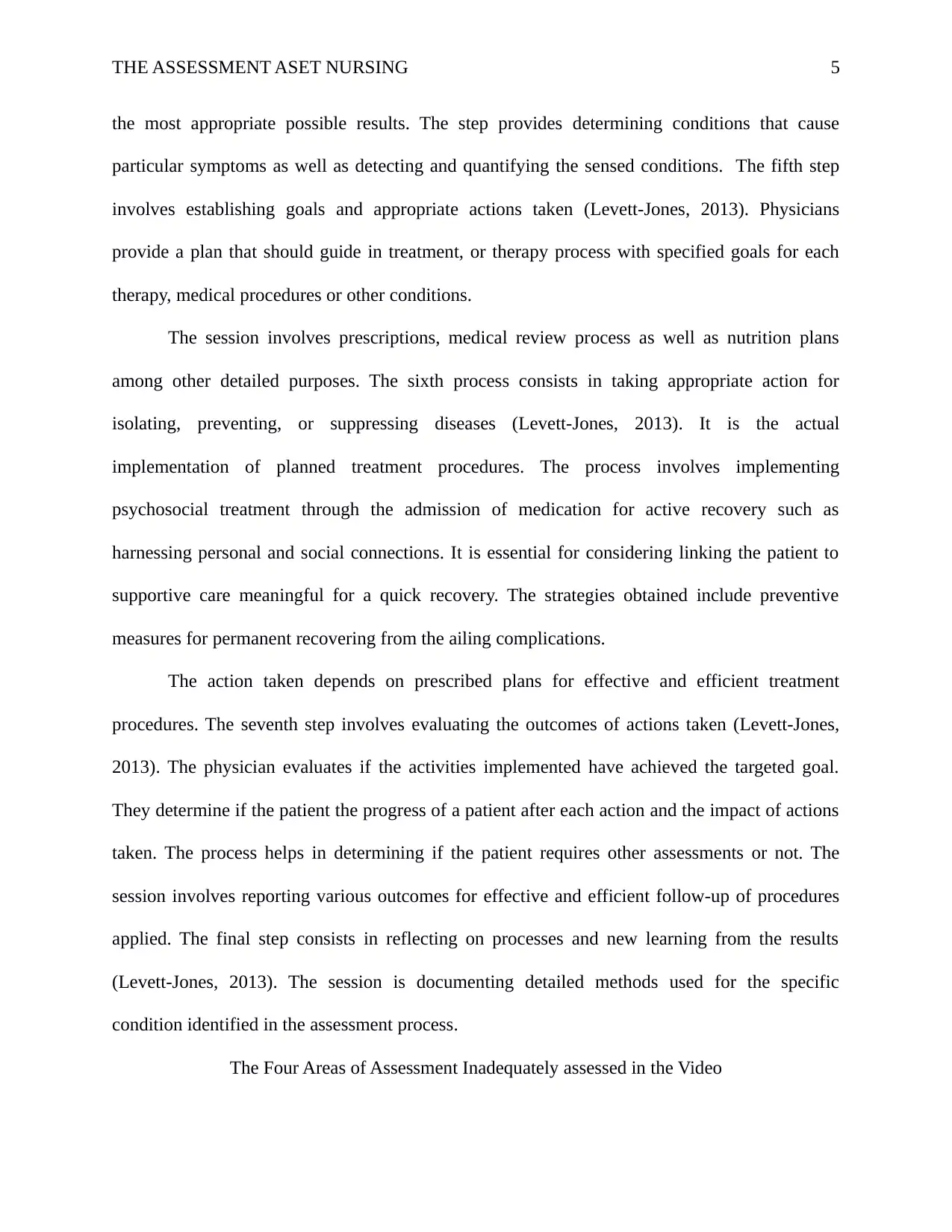
THE ASSESSMENT ASET NURSING 5
the most appropriate possible results. The step provides determining conditions that cause
particular symptoms as well as detecting and quantifying the sensed conditions. The fifth step
involves establishing goals and appropriate actions taken (Levett-Jones, 2013). Physicians
provide a plan that should guide in treatment, or therapy process with specified goals for each
therapy, medical procedures or other conditions.
The session involves prescriptions, medical review process as well as nutrition plans
among other detailed purposes. The sixth process consists in taking appropriate action for
isolating, preventing, or suppressing diseases (Levett-Jones, 2013). It is the actual
implementation of planned treatment procedures. The process involves implementing
psychosocial treatment through the admission of medication for active recovery such as
harnessing personal and social connections. It is essential for considering linking the patient to
supportive care meaningful for a quick recovery. The strategies obtained include preventive
measures for permanent recovering from the ailing complications.
The action taken depends on prescribed plans for effective and efficient treatment
procedures. The seventh step involves evaluating the outcomes of actions taken (Levett-Jones,
2013). The physician evaluates if the activities implemented have achieved the targeted goal.
They determine if the patient the progress of a patient after each action and the impact of actions
taken. The process helps in determining if the patient requires other assessments or not. The
session involves reporting various outcomes for effective and efficient follow-up of procedures
applied. The final step consists in reflecting on processes and new learning from the results
(Levett-Jones, 2013). The session is documenting detailed methods used for the specific
condition identified in the assessment process.
The Four Areas of Assessment Inadequately assessed in the Video
the most appropriate possible results. The step provides determining conditions that cause
particular symptoms as well as detecting and quantifying the sensed conditions. The fifth step
involves establishing goals and appropriate actions taken (Levett-Jones, 2013). Physicians
provide a plan that should guide in treatment, or therapy process with specified goals for each
therapy, medical procedures or other conditions.
The session involves prescriptions, medical review process as well as nutrition plans
among other detailed purposes. The sixth process consists in taking appropriate action for
isolating, preventing, or suppressing diseases (Levett-Jones, 2013). It is the actual
implementation of planned treatment procedures. The process involves implementing
psychosocial treatment through the admission of medication for active recovery such as
harnessing personal and social connections. It is essential for considering linking the patient to
supportive care meaningful for a quick recovery. The strategies obtained include preventive
measures for permanent recovering from the ailing complications.
The action taken depends on prescribed plans for effective and efficient treatment
procedures. The seventh step involves evaluating the outcomes of actions taken (Levett-Jones,
2013). The physician evaluates if the activities implemented have achieved the targeted goal.
They determine if the patient the progress of a patient after each action and the impact of actions
taken. The process helps in determining if the patient requires other assessments or not. The
session involves reporting various outcomes for effective and efficient follow-up of procedures
applied. The final step consists in reflecting on processes and new learning from the results
(Levett-Jones, 2013). The session is documenting detailed methods used for the specific
condition identified in the assessment process.
The Four Areas of Assessment Inadequately assessed in the Video
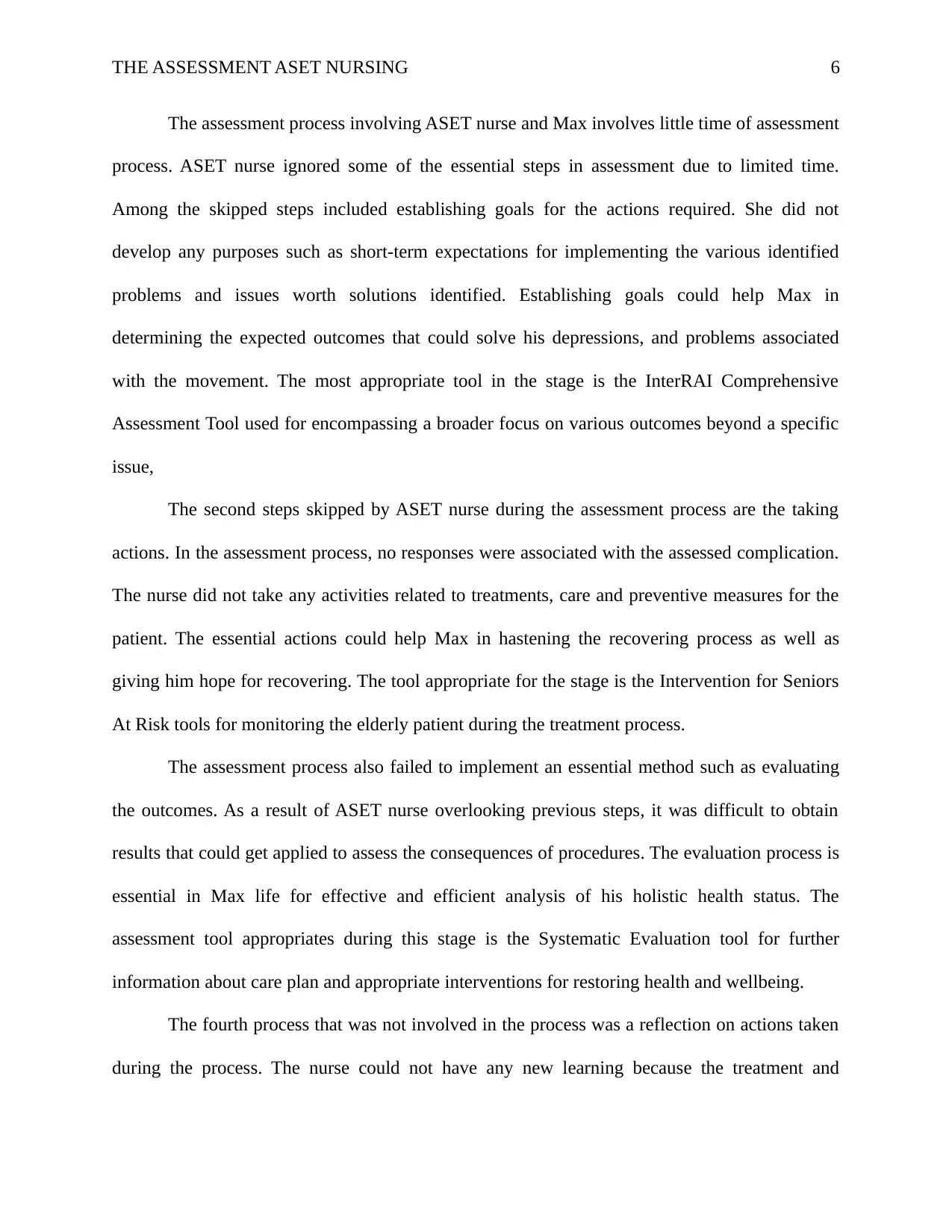
THE ASSESSMENT ASET NURSING 6
The assessment process involving ASET nurse and Max involves little time of assessment
process. ASET nurse ignored some of the essential steps in assessment due to limited time.
Among the skipped steps included establishing goals for the actions required. She did not
develop any purposes such as short-term expectations for implementing the various identified
problems and issues worth solutions identified. Establishing goals could help Max in
determining the expected outcomes that could solve his depressions, and problems associated
with the movement. The most appropriate tool in the stage is the InterRAI Comprehensive
Assessment Tool used for encompassing a broader focus on various outcomes beyond a specific
issue,
The second steps skipped by ASET nurse during the assessment process are the taking
actions. In the assessment process, no responses were associated with the assessed complication.
The nurse did not take any activities related to treatments, care and preventive measures for the
patient. The essential actions could help Max in hastening the recovering process as well as
giving him hope for recovering. The tool appropriate for the stage is the Intervention for Seniors
At Risk tools for monitoring the elderly patient during the treatment process.
The assessment process also failed to implement an essential method such as evaluating
the outcomes. As a result of ASET nurse overlooking previous steps, it was difficult to obtain
results that could get applied to assess the consequences of procedures. The evaluation process is
essential in Max life for effective and efficient analysis of his holistic health status. The
assessment tool appropriates during this stage is the Systematic Evaluation tool for further
information about care plan and appropriate interventions for restoring health and wellbeing.
The fourth process that was not involved in the process was a reflection on actions taken
during the process. The nurse could not have any new learning because the treatment and
The assessment process involving ASET nurse and Max involves little time of assessment
process. ASET nurse ignored some of the essential steps in assessment due to limited time.
Among the skipped steps included establishing goals for the actions required. She did not
develop any purposes such as short-term expectations for implementing the various identified
problems and issues worth solutions identified. Establishing goals could help Max in
determining the expected outcomes that could solve his depressions, and problems associated
with the movement. The most appropriate tool in the stage is the InterRAI Comprehensive
Assessment Tool used for encompassing a broader focus on various outcomes beyond a specific
issue,
The second steps skipped by ASET nurse during the assessment process are the taking
actions. In the assessment process, no responses were associated with the assessed complication.
The nurse did not take any activities related to treatments, care and preventive measures for the
patient. The essential actions could help Max in hastening the recovering process as well as
giving him hope for recovering. The tool appropriate for the stage is the Intervention for Seniors
At Risk tools for monitoring the elderly patient during the treatment process.
The assessment process also failed to implement an essential method such as evaluating
the outcomes. As a result of ASET nurse overlooking previous steps, it was difficult to obtain
results that could get applied to assess the consequences of procedures. The evaluation process is
essential in Max life for effective and efficient analysis of his holistic health status. The
assessment tool appropriates during this stage is the Systematic Evaluation tool for further
information about care plan and appropriate interventions for restoring health and wellbeing.
The fourth process that was not involved in the process was a reflection on actions taken
during the process. The nurse could not have any new learning because the treatment and
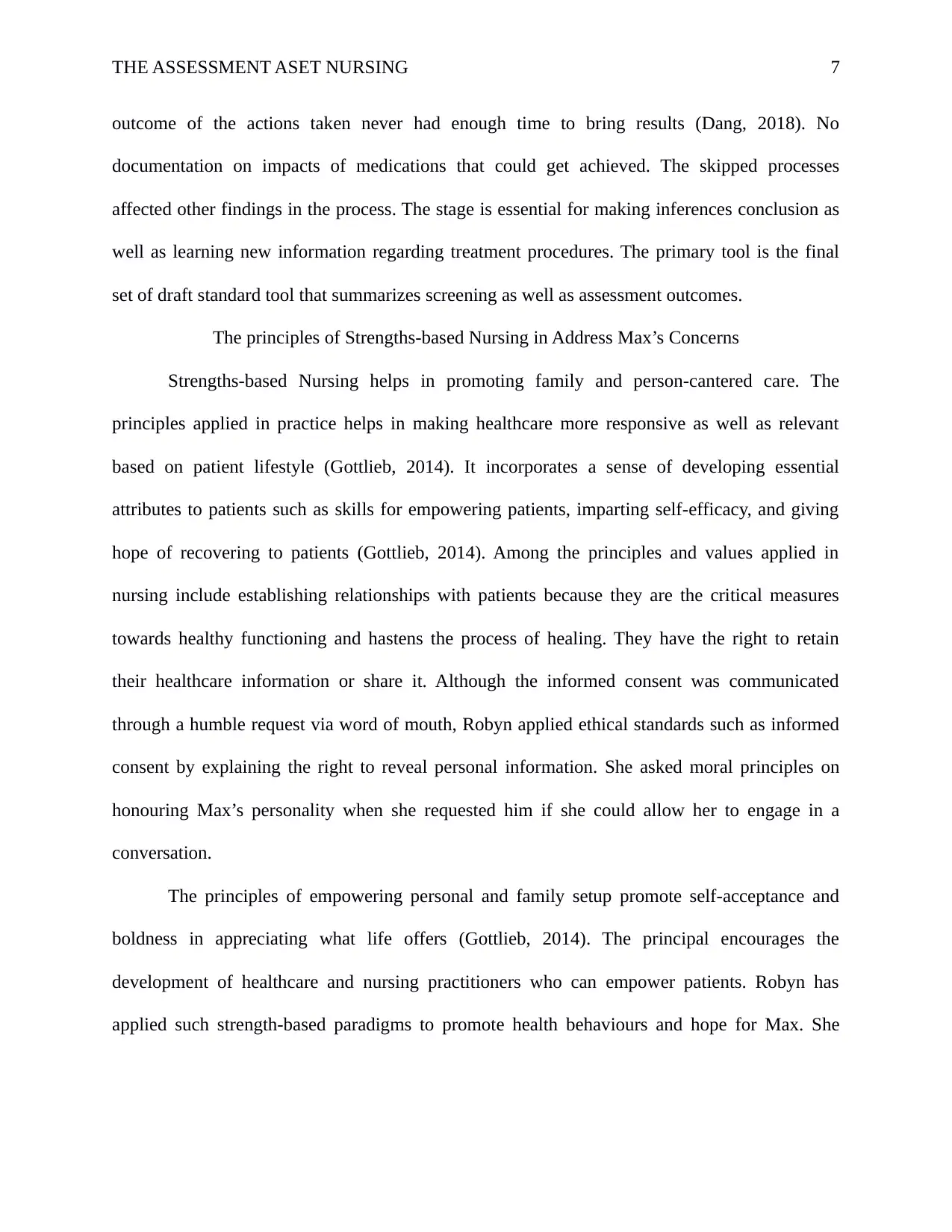
THE ASSESSMENT ASET NURSING 7
outcome of the actions taken never had enough time to bring results (Dang, 2018). No
documentation on impacts of medications that could get achieved. The skipped processes
affected other findings in the process. The stage is essential for making inferences conclusion as
well as learning new information regarding treatment procedures. The primary tool is the final
set of draft standard tool that summarizes screening as well as assessment outcomes.
The principles of Strengths-based Nursing in Address Max’s Concerns
Strengths-based Nursing helps in promoting family and person-cantered care. The
principles applied in practice helps in making healthcare more responsive as well as relevant
based on patient lifestyle (Gottlieb, 2014). It incorporates a sense of developing essential
attributes to patients such as skills for empowering patients, imparting self-efficacy, and giving
hope of recovering to patients (Gottlieb, 2014). Among the principles and values applied in
nursing include establishing relationships with patients because they are the critical measures
towards healthy functioning and hastens the process of healing. They have the right to retain
their healthcare information or share it. Although the informed consent was communicated
through a humble request via word of mouth, Robyn applied ethical standards such as informed
consent by explaining the right to reveal personal information. She asked moral principles on
honouring Max’s personality when she requested him if she could allow her to engage in a
conversation.
The principles of empowering personal and family setup promote self-acceptance and
boldness in appreciating what life offers (Gottlieb, 2014). The principal encourages the
development of healthcare and nursing practitioners who can empower patients. Robyn has
applied such strength-based paradigms to promote health behaviours and hope for Max. She
outcome of the actions taken never had enough time to bring results (Dang, 2018). No
documentation on impacts of medications that could get achieved. The skipped processes
affected other findings in the process. The stage is essential for making inferences conclusion as
well as learning new information regarding treatment procedures. The primary tool is the final
set of draft standard tool that summarizes screening as well as assessment outcomes.
The principles of Strengths-based Nursing in Address Max’s Concerns
Strengths-based Nursing helps in promoting family and person-cantered care. The
principles applied in practice helps in making healthcare more responsive as well as relevant
based on patient lifestyle (Gottlieb, 2014). It incorporates a sense of developing essential
attributes to patients such as skills for empowering patients, imparting self-efficacy, and giving
hope of recovering to patients (Gottlieb, 2014). Among the principles and values applied in
nursing include establishing relationships with patients because they are the critical measures
towards healthy functioning and hastens the process of healing. They have the right to retain
their healthcare information or share it. Although the informed consent was communicated
through a humble request via word of mouth, Robyn applied ethical standards such as informed
consent by explaining the right to reveal personal information. She asked moral principles on
honouring Max’s personality when she requested him if she could allow her to engage in a
conversation.
The principles of empowering personal and family setup promote self-acceptance and
boldness in appreciating what life offers (Gottlieb, 2014). The principal encourages the
development of healthcare and nursing practitioners who can empower patients. Robyn has
applied such strength-based paradigms to promote health behaviours and hope for Max. She
Paraphrase This Document
Need a fresh take? Get an instant paraphrase of this document with our AI Paraphraser
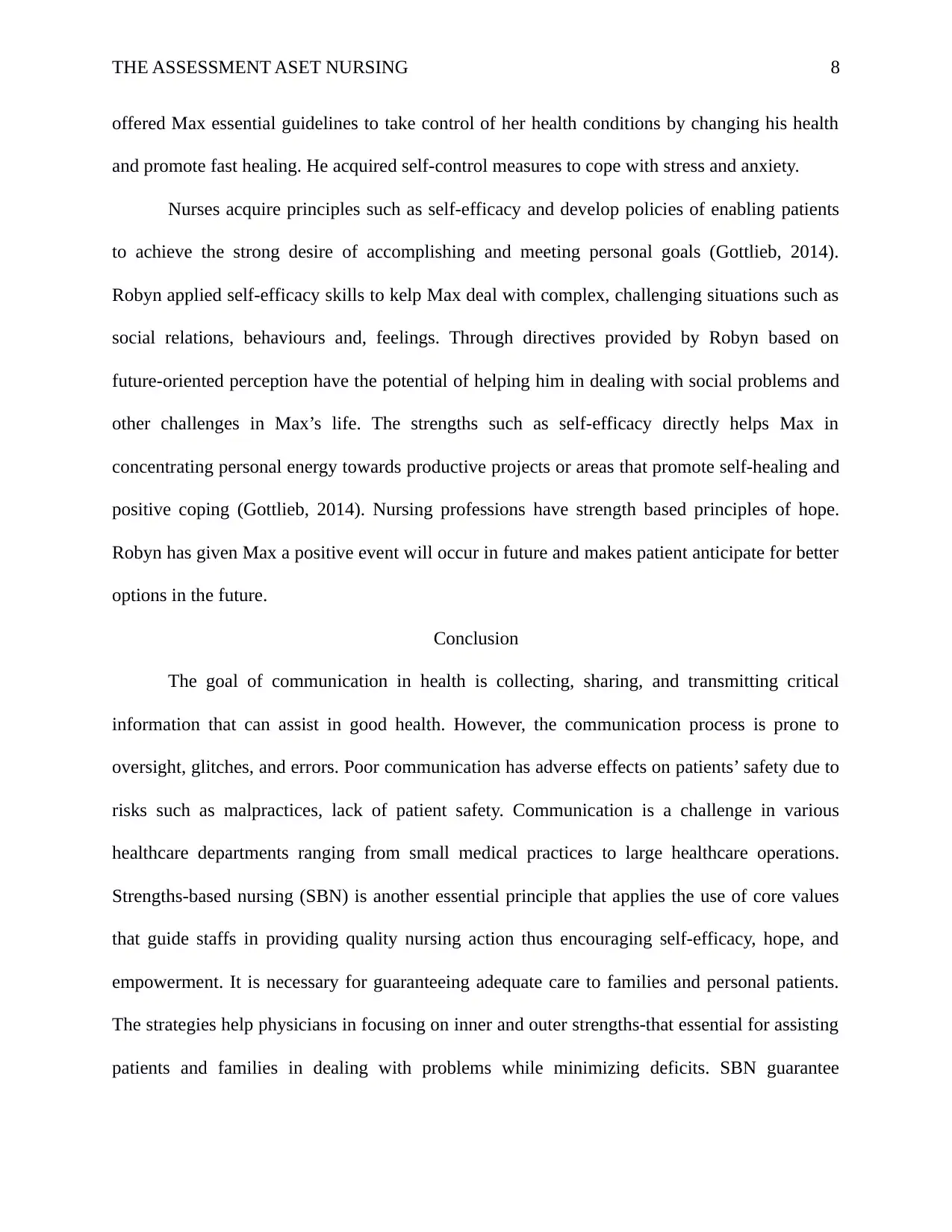
THE ASSESSMENT ASET NURSING 8
offered Max essential guidelines to take control of her health conditions by changing his health
and promote fast healing. He acquired self-control measures to cope with stress and anxiety.
Nurses acquire principles such as self-efficacy and develop policies of enabling patients
to achieve the strong desire of accomplishing and meeting personal goals (Gottlieb, 2014).
Robyn applied self-efficacy skills to kelp Max deal with complex, challenging situations such as
social relations, behaviours and, feelings. Through directives provided by Robyn based on
future-oriented perception have the potential of helping him in dealing with social problems and
other challenges in Max’s life. The strengths such as self-efficacy directly helps Max in
concentrating personal energy towards productive projects or areas that promote self-healing and
positive coping (Gottlieb, 2014). Nursing professions have strength based principles of hope.
Robyn has given Max a positive event will occur in future and makes patient anticipate for better
options in the future.
Conclusion
The goal of communication in health is collecting, sharing, and transmitting critical
information that can assist in good health. However, the communication process is prone to
oversight, glitches, and errors. Poor communication has adverse effects on patients’ safety due to
risks such as malpractices, lack of patient safety. Communication is a challenge in various
healthcare departments ranging from small medical practices to large healthcare operations.
Strengths-based nursing (SBN) is another essential principle that applies the use of core values
that guide staffs in providing quality nursing action thus encouraging self-efficacy, hope, and
empowerment. It is necessary for guaranteeing adequate care to families and personal patients.
The strategies help physicians in focusing on inner and outer strengths-that essential for assisting
patients and families in dealing with problems while minimizing deficits. SBN guarantee
offered Max essential guidelines to take control of her health conditions by changing his health
and promote fast healing. He acquired self-control measures to cope with stress and anxiety.
Nurses acquire principles such as self-efficacy and develop policies of enabling patients
to achieve the strong desire of accomplishing and meeting personal goals (Gottlieb, 2014).
Robyn applied self-efficacy skills to kelp Max deal with complex, challenging situations such as
social relations, behaviours and, feelings. Through directives provided by Robyn based on
future-oriented perception have the potential of helping him in dealing with social problems and
other challenges in Max’s life. The strengths such as self-efficacy directly helps Max in
concentrating personal energy towards productive projects or areas that promote self-healing and
positive coping (Gottlieb, 2014). Nursing professions have strength based principles of hope.
Robyn has given Max a positive event will occur in future and makes patient anticipate for better
options in the future.
Conclusion
The goal of communication in health is collecting, sharing, and transmitting critical
information that can assist in good health. However, the communication process is prone to
oversight, glitches, and errors. Poor communication has adverse effects on patients’ safety due to
risks such as malpractices, lack of patient safety. Communication is a challenge in various
healthcare departments ranging from small medical practices to large healthcare operations.
Strengths-based nursing (SBN) is another essential principle that applies the use of core values
that guide staffs in providing quality nursing action thus encouraging self-efficacy, hope, and
empowerment. It is necessary for guaranteeing adequate care to families and personal patients.
The strategies help physicians in focusing on inner and outer strengths-that essential for assisting
patients and families in dealing with problems while minimizing deficits. SBN guarantee
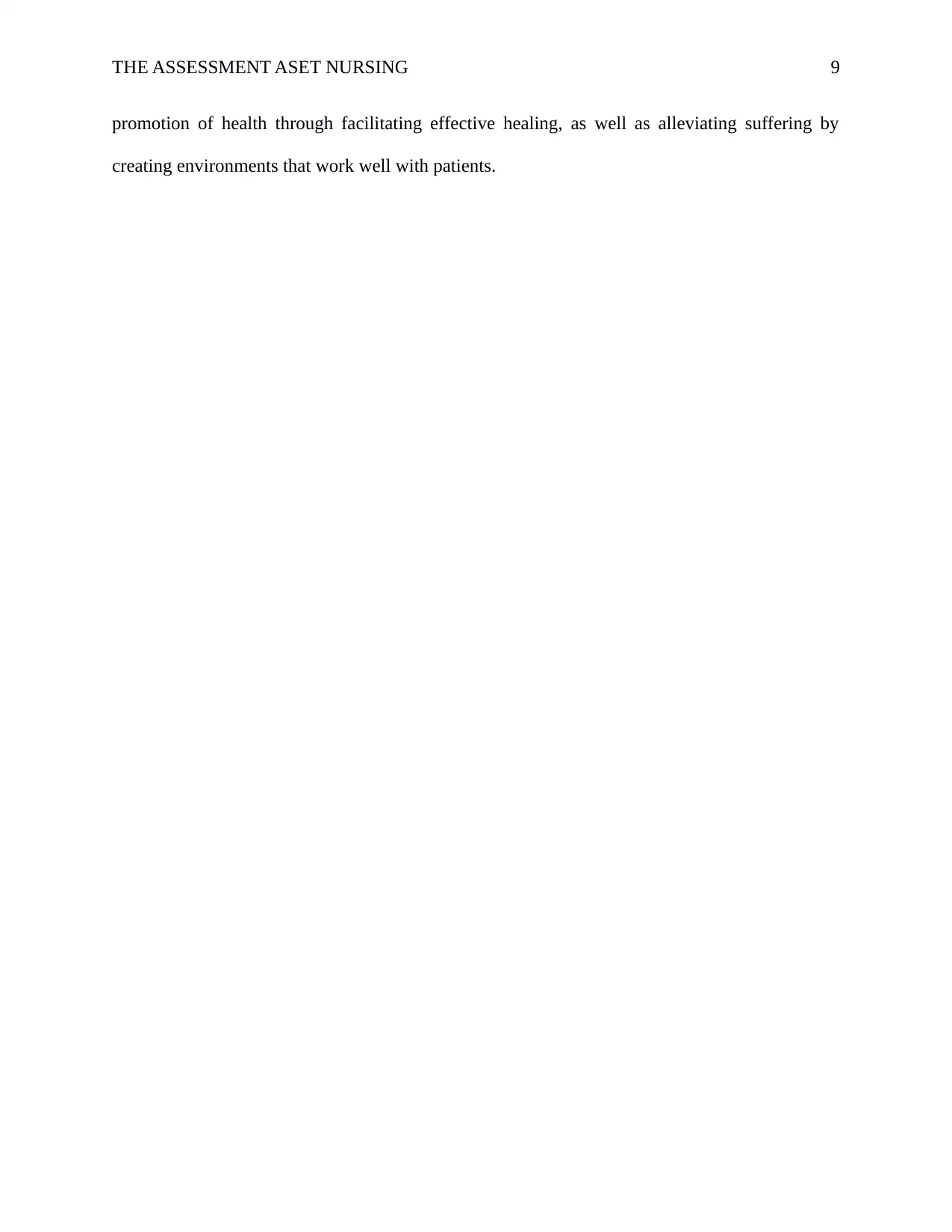
THE ASSESSMENT ASET NURSING 9
promotion of health through facilitating effective healing, as well as alleviating suffering by
creating environments that work well with patients.
promotion of health through facilitating effective healing, as well as alleviating suffering by
creating environments that work well with patients.
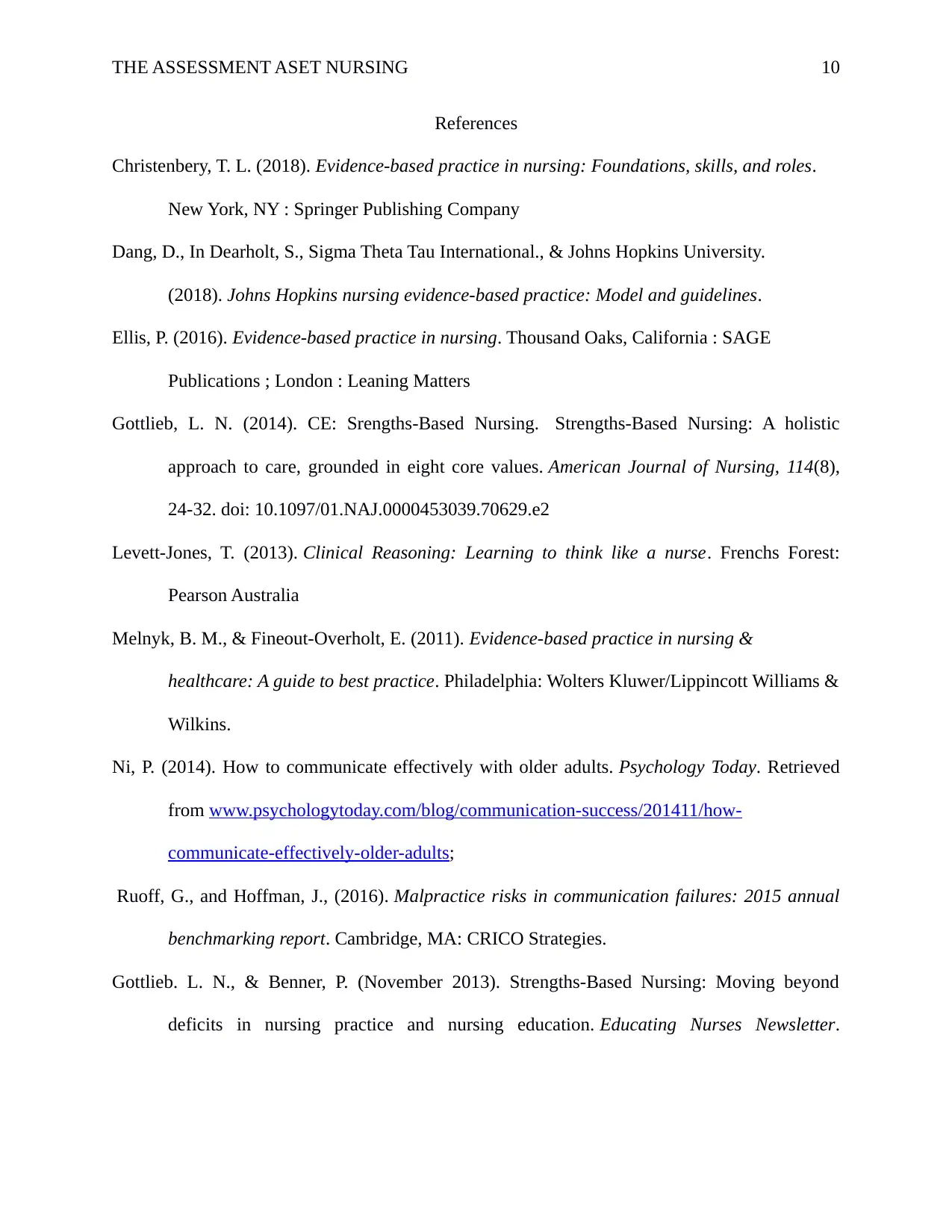
THE ASSESSMENT ASET NURSING 10
References
Christenbery, T. L. (2018). Evidence-based practice in nursing: Foundations, skills, and roles.
New York, NY : Springer Publishing Company
Dang, D., In Dearholt, S., Sigma Theta Tau International., & Johns Hopkins University.
(2018). Johns Hopkins nursing evidence-based practice: Model and guidelines.
Ellis, P. (2016). Evidence-based practice in nursing. Thousand Oaks, California : SAGE
Publications ; London : Leaning Matters
Gottlieb, L. N. (2014). CE: Srengths-Based Nursing. Strengths-Based Nursing: A holistic
approach to care, grounded in eight core values. American Journal of Nursing, 114(8),
24-32. doi: 10.1097/01.NAJ.0000453039.70629.e2
Levett-Jones, T. (2013). Clinical Reasoning: Learning to think like a nurse. Frenchs Forest:
Pearson Australia
Melnyk, B. M., & Fineout-Overholt, E. (2011). Evidence-based practice in nursing &
healthcare: A guide to best practice. Philadelphia: Wolters Kluwer/Lippincott Williams &
Wilkins.
Ni, P. (2014). How to communicate effectively with older adults. Psychology Today. Retrieved
from www.psychologytoday.com/blog/communication-success/201411/how-
communicate-effectively-older-adults;
Ruoff, G., and Hoffman, J., (2016). Malpractice risks in communication failures: 2015 annual
benchmarking report. Cambridge, MA: CRICO Strategies.
Gottlieb. L. N., & Benner, P. (November 2013). Strengths-Based Nursing: Moving beyond
deficits in nursing practice and nursing education. Educating Nurses Newsletter.
References
Christenbery, T. L. (2018). Evidence-based practice in nursing: Foundations, skills, and roles.
New York, NY : Springer Publishing Company
Dang, D., In Dearholt, S., Sigma Theta Tau International., & Johns Hopkins University.
(2018). Johns Hopkins nursing evidence-based practice: Model and guidelines.
Ellis, P. (2016). Evidence-based practice in nursing. Thousand Oaks, California : SAGE
Publications ; London : Leaning Matters
Gottlieb, L. N. (2014). CE: Srengths-Based Nursing. Strengths-Based Nursing: A holistic
approach to care, grounded in eight core values. American Journal of Nursing, 114(8),
24-32. doi: 10.1097/01.NAJ.0000453039.70629.e2
Levett-Jones, T. (2013). Clinical Reasoning: Learning to think like a nurse. Frenchs Forest:
Pearson Australia
Melnyk, B. M., & Fineout-Overholt, E. (2011). Evidence-based practice in nursing &
healthcare: A guide to best practice. Philadelphia: Wolters Kluwer/Lippincott Williams &
Wilkins.
Ni, P. (2014). How to communicate effectively with older adults. Psychology Today. Retrieved
from www.psychologytoday.com/blog/communication-success/201411/how-
communicate-effectively-older-adults;
Ruoff, G., and Hoffman, J., (2016). Malpractice risks in communication failures: 2015 annual
benchmarking report. Cambridge, MA: CRICO Strategies.
Gottlieb. L. N., & Benner, P. (November 2013). Strengths-Based Nursing: Moving beyond
deficits in nursing practice and nursing education. Educating Nurses Newsletter.
Secure Best Marks with AI Grader
Need help grading? Try our AI Grader for instant feedback on your assignments.

THE ASSESSMENT ASET NURSING 11
Retrieved from http://www.educatingnurses.com/articles/strengths-based-nursing-
moving-beyond-deficits-in-nursing-practice-and-nursing-education/
Retrieved from http://www.educatingnurses.com/articles/strengths-based-nursing-
moving-beyond-deficits-in-nursing-practice-and-nursing-education/
1 out of 11
Related Documents
Your All-in-One AI-Powered Toolkit for Academic Success.
+13062052269
info@desklib.com
Available 24*7 on WhatsApp / Email
![[object Object]](/_next/static/media/star-bottom.7253800d.svg)
Unlock your academic potential
© 2024 | Zucol Services PVT LTD | All rights reserved.




